Now that the latest Overstreet Price Guide has included an article on the Canadian war-time comic books and now that the books themselves are beginning to realize handsome price ranges, is it time to put together a Canadian WECA Price Guide, or Canadian Golden Age Price Guide, or Canadian “Whites” Price Guide, or whatever we want to call it?
Two very early efforts tried pricing Canadian comics back in 1986 when little was really known about the Whites. These were a section of John Bell’s Canuck Comics and Theaker’s two part pamphlet set called an Introduction to Canadian Comic Books.
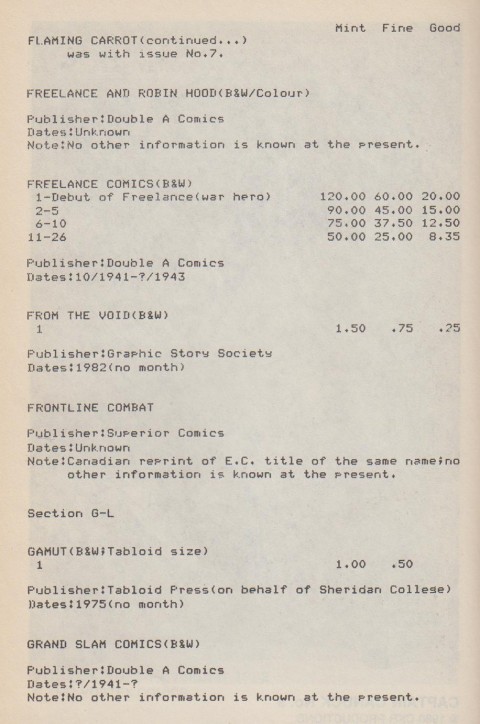
The next question to ask is “Should this Canadian Guide be included as a sub-section of the existing Overstreet Price Guide, such as the Platinum books or Promotional books already are, or should it be a stand-alone book, or an e-book, or just have some sort of online presence such as being part of our existing web site database (www.canadasowncomics.com) that’s currently being completed and populated?”
The guide itself would comprise roughly 750 books (maybe even up to 800) but this is significantly less than the run of Action or Detective Comics alone. At the very least it would be the best checklist for these books produced so far. But could the prices listed mean anything real at this point? They would certainly be the best estimate we could come up with given the sales data we have now and it would be the necessary starting point for where we would need to eventually get to—a solidly accurate indication of the market value for these comics.
Let’s take as an example of a possible starting point the price of one of the purchases listed by master Whites collector Stephen Lipson books reported as purchased recently in this year’s Overstreet Comic Book Price Guide. Remember that the seven books Stephen lists were all purchased in 2013 before this year’s ComicLink auctions (see my earlier posts on the 1st and 2nd of these).
The first book on Stephen’s list is Freelance Comics Vol. 1 No. 1 (June –July 1941) which was the third WECA title to appear after Better Comics, Robin Hood Comics, and Union Jack-Lucky Comics and probably just before Triumph Comics No. 1 (August, 1941). Stephen bought this key in 2013 for $1,000 and the Overstreet breakdown would be:
| 2.0 | 4.0 | 6.0 | 8.0 | 9.0 | 9.2 | |
| Freelance Vol. 1 No. 1 | 1,000 | 2,000 | 3,000 | 7,500 | 12,750 | 18,000 |
This would put the book in the range of an Action Comics 11, a Detective Comics 40 or a Captain America 5 from the Golden Age and within the range of an X-Men 1 or Tales of Suspense 39 from the Silver Age.
But now let’s compare this with a couple of books from the first CLINK auction in February. Wow Comics No. 1 (3.0 at $1600), Active Comics No. 1 (3.5 at $1425 – which was a bargain grab because this was the first book in the auction) and Triumph Comics No. 17 (4.0 at $1750) all, more or less, fall within the range of the Freelance 1 mentioned above. In fact if that Freelance 1 would have been in this auction, it would have probably handsomely bettered the price that Stephen originally paid for it a year or so ago.
If the 1945 Nelvana 15 cent one-shot compendium from the same auction, which at 6.5 went for $13,750 wasn’t an anomaly, then we get the following type of spread:
| 2.0 | 4.0 | 6.0 | 8.0 | 9.0 | 9.2 | |
| Nelvana 1945 one-shot | 3,000 | 6,500 | 10,000 | 22,500 | 50,000 | 75,000 |
This is unbelievably in line with Marvel Mystery No. 2. To me it can’t be right, but is this the gradient that should appear in the price guide? My own belief is that the newly exploding awareness of these Canadian war-time comics at the time and a curious back story tug of war bidding frenzy produced this, to me, unwarranted price point… but I may be wrong.
Where then do some of the WECA books we have to consider the most valuable fit in such as Triumph No. 1 (six known copies), Better Comics No. 1 (maybe 4 or 5 known copies), Top Flight Comics, and the yet to appear Robin Hood Comics No. 1? Sales of these books are so rare that you have no back data to base a price point suggestion on.
Also, should a curious 5 cent newsprint comic like Ted Steele’s Rocket No. 1, which came out right after Better Comics No. 1 and has a super hero (Wolf Savage) but isn’t paneled, be included in the guide?
However, the point is that we need to start somewhere and “somewhen” even though accuracy may suffer at the start but we should have the confidence to believe that over time, and as knowledge and appreciation of these books becomes more widespread, and as we find more market place price points and sales to incorporate into our data, we should be able to offer more precision and concreteness in the suggested ranges that these books should fall.
However, a good price guide is not just about dollars and cents, it should be informative and “tag” or profile those books that have significant and historic content. Here’s a list of what I think a quality comic price guide should also offer information on:
- Significant first appearances and origin issues (heroes and villains).
- First and last work by a creator (artist and/or writer).
- Start and end of significant arcs.
- Use of historically significant personages (Hitler, Mussolini, Tojo, appearances).
- Significant covers (e.g., first Nelvana cover and which books have Nelvana covers, Nazi covers, bondage covers, etc.).
- Collectable “themed” stories such as robot stories, dinosaur stories, zombie stories, etc..
- Changes in format or production values in a title (e.g., the tabloid appearance of Robin Hood Comics No. 1, the gradual transition of Wow Comics from full colour in issue No. 1 to two-colour and black and white by issues No. 8 and 9, the multi-pastel colour of paper used in early issues of Better Comics, the transition into full colour production at the end of the war, etc.).
- Historic background publishing decisions and changes (e.g. the folding of Hillborough Studios and the move of Adrian Dingle to Bell Features in the spring of 1942, the licensing and redrawing of Fawcett heroes by Anglo-American at the start of 1942, the printing and publishing of some later full colour Anglo-American comics in Cleveland, etc.).
- Variants and possible multiple printings.
- Number of known existing copies leading perhaps to a Gerber-type rating.
- Any crossovers or cameos.
- Artists drawing themselves into the story.
Those are points I can think of off the top of my head. I’m sure readers have some additional suggestions that are well-taken.
On the other hand, I could imagine that some people could be against setting down a price guide for these books because dealer prices (Bruno in Montreal is amazing, isn’t he?) may significantly escalate and non-collectors who discover some of these books in their attics and barns may start demanding, as they invariably do, unrealistic first prices for their finds. But it’s up to buyers and dealers on the receiving side to explain how guide prices relate to real market and resale values. Some people are not going to warm up to a price guide for these books because the bargains that were available in a previously uniformed and unhyped market may no longer be there, but if you’ve been a collector for as long as I have (over 50 years), you know that you can’t hold back the inevitable and make this your own secret collectible kingdom forever. It happened to Golden Age collectors when the first issue of Overstreet came out with its black and white paper cover in 1970 and in every subsequent decade as the Silver Age and Bronze Age markets grew and later when proper comic book movies started appearing. (Don’t Fear) The Reaper.
Remember that some of these Canadian books are already priced in the guide. For example there’s the giant Captain America 128 pg. Canadian reprint collection (which is listed in Overstreet as mistakenly having 132 pages.) which, at this time is probably the most expensive Canadian war time comic. The partner of this book is the Canadian Marvel Mystery 128 pager which is also in the price guide.
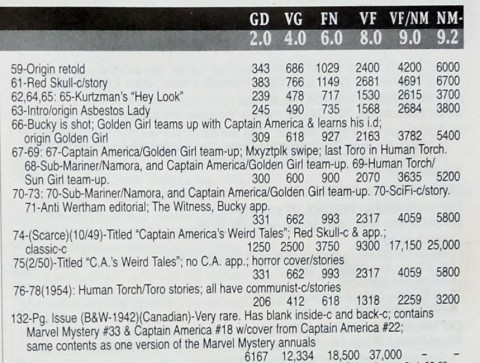
Dizzy Don also has a presence in the current guide as well but instead of the first twenty issues being properly listed as The Funny Comics and published by Bell Features, they are incorrectly called issues of Dizzy Don Comics. The Funny Comics became Dizzy Don Comics when Manny Eason, the creator, broke away from Bell Features and formed his own publishing company called Dizzy Don Enterprises. Both issues 21 and 22 were in full colour.

Some Canadian Rucker Publications books such as Scooter Comics (though it overlooks the existence of a second issue) can also be found in the guide, but the existing listing for Weekender Comics is much more interesting even though it gets the date of issue No. 1 a little wrong and also makes no mention of the of the newspaper type sections called “The Illustrated News” and reporting Canadian news that were in the middle of each book.
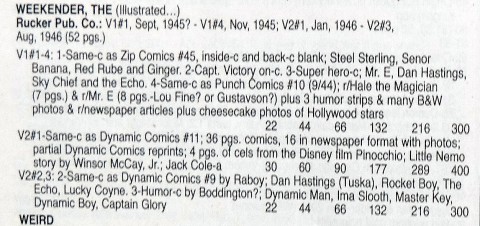
In the end, the question remains, “Is this the time to put together a first, working price guide for these Canadian war-time comic books?” I’m not even sure that Overstreet would want a price guide section for next year’s guide, but we have the people in place that could assemble a solid first effort. Should one appear in next year’s Overstreet guide?

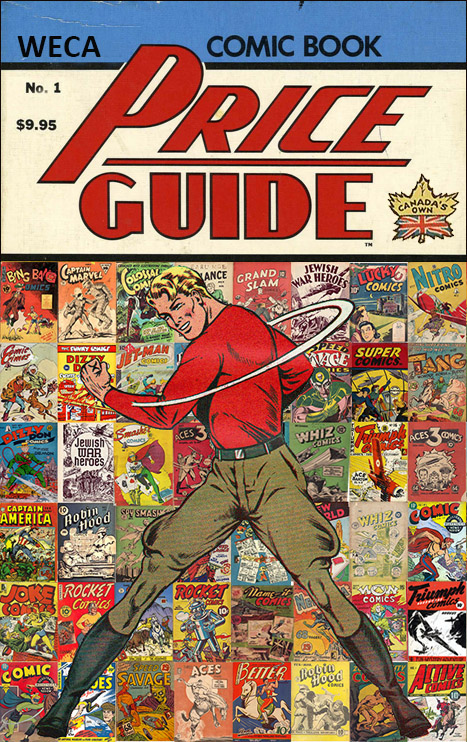
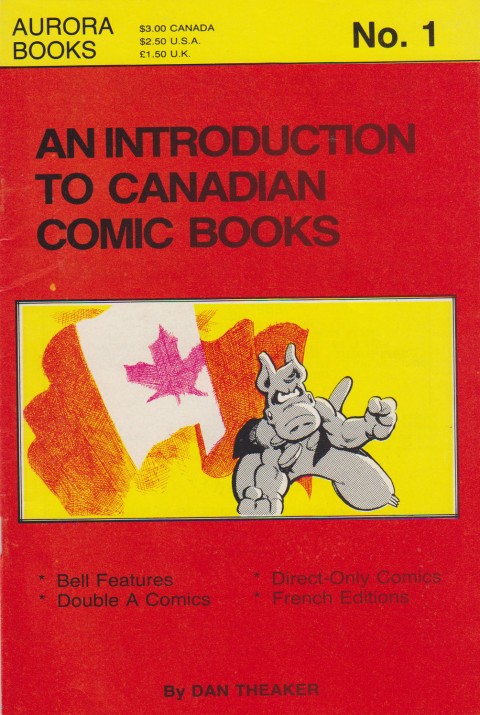



Ivan, A price guide is inevitable, and better from you and the folks that know best and who can do a top-notch job. Otherwise, and I’ve seen it, someone else will jump in with bad data and, perhaps, self-serving pricing. It would be best to get it into Overstreet, but you need to force the issue with them. If they won’t commit, then you guys should do it yourselves. But it only makes sense to have it there, it’s where everything else is already.
I like what the Underground Comics Price Guide does: they include “HRP=Highest Realized Price.” That way you can see a top auction sale, but one sale can’t sway the entire structure. I see it very hard right now to have enough data to work with, and things may lean into the HIGH side because of scarcity and some very moneyed buyers. Best to be conservative but still get something out there.
As the word gets out, and I firmly believe in this, more copies will surface. And hopefully some may be preserved from being destroyed. High prices always bring a lot of unknown material out…example is Zap #1, all those “sold from the babycart” copies, now seeming a bit overstated as more and more get slabbed.
The biggest value is still the other data, that you so carefully listed. I’ve slowly been incorporating your blog data into my want list, because I use this stuff–well, if I could find any copies, I would. For so many collectors, that is as or more important than price suggestions, to separate the wheat from the chaff.
To have that all in one place would be great. Since the universe is relatively small, it won’t take a lot of pages in Overstreet. Push on them to commit to getting it in AND to pull out their bad data and get it corrected in your “section.” Good luck!
The problem is the small sample size. As of this post you can count on 2 hands the number of known copies of most of the key issues from this era. I’m not sure the guide listings could deliver accurate price recommendations at this point.
Hopefully Mr. Plant is right and we get more copies surfacing as record sales hit the news. With more available copies and with some consistent commerce for the Whites adding to a growing sales database we could get a more accurate read on prices.
Again borrowing from Mr. Plants comment I think the listing in any guide would be most beneficial as a resource for things like 1st appearances, 1st cross overs, hero appearances on covers, artists involved and other features a particular book brings that could differentiate it from others and thus affect demand.
I have no intention of contributing to the publication of a price guide. Let the market bear what somebody is comfortable paying for a Canadian White, instead of manipulating prices based on sales data that could very much be anomalies. I am firm in my position
Great suggestions coming with a guy with so much experience, Bud. Thanks. To me as well, the price points on these books are secondary to the other data that could be assembled in the list. I really like the idea of a highest realized price (HRP). What we need to do is make sure that those of us that want to make it happen can discuss how best to go about it and then make a solid proposal to Jeff Vaughn at Overstreet and see what he and Bob Overstreet have to say. Maybe pointing out to them that some of the data they have already published is messed up. Anyway, let’s take this step by step and see where it goes.
Maybe the first submission to Overstreet should be just a checklist containing all the data I referred to in my post. On the other hand, maybe we should place a large disclaimer at the start of it saying that sales data is so low that prices may vary wildly and ours are just a suggested range that comes from searching for and collecting these books over a long period. Quite a lot to think about. At least we should be able to indicate what books are the most sought after issues and what are currently hot books from this era.
Your viewpoint is very valid, as always, Stephen. What could unintentionally be created is a “Frankentstein Monster” of a guide that would ironically come back to bite us with the force of unrealistic prices. But I do remember hearing almost exactly the same argument at the end of the sixties from Golden Age collectors just before the first issue of Overstreet came out. They claimed that it would lead to the ruin of the market and regulate it in a way that was unnatural. Now Overstreet is the “Bible” in the field.
I think a price guide for the Whites in inevitable. Rushing into one may be problematic in that too much may be left to guess work and “feel”. I’d like to see these things traded opening on a more consistent basis generating better data leading to a more accurate guide.
Hopefully this will only take a year and your suggestion of having the initial listing as a check list could start things off.
Even if a price listing goes up the year after disclaimers may have to be added ( I’ve seen that in the OPG “prices vary widely on this book” – this may have to appear at the beginning of this guide “prices vary widely on these books”.
Recorded data on sites like GPA will not be enough to offer thoroughly accurate pricing structures either. A small fraction of Whites are graded and even then there are some auction sites not covered by the likes of GPA,.
Again, I think the guide’s best feature will be the itemization of what issues bring what and lets not forget that new facts come to light all the time making annual updates of the listing necessary (the guide has done this for 44 years already for the US comics).
I’d settle for a check list in next years guide!
Thank you for your feedback Ivan. In fact, I was not aware that there were arguments against a price guide back in the 60’s, prior to the publication of the first Overstreet.
That being said, I recall being offered a copy of Wow Comics # 23 in high grade with a nice Dingle Penguin cover by a deale,r and this is how the conversation went:
Me: How much would you like for this book
Dealer: There is no price guide. How about $150.00?
Me: Ok
So, what is fair market value on this book? Right now it is what somebody is willing to pay for the item. I would have paid perhaps $600.00 for that book. Perhaps somebody else would have paid north of $1K. The seller sold the book for what he/she felt it was worth. In any event, a price guide could as you say create a “Monster”
Oh, did I mention that this transaction with the Wow # 23 transpired less than 2 months ago? I also seem to recall Ivan that you paid approximately $100.00 for a very nice copy of Better Comics Vol 2 #1, with an iconic Iron Man cover from a person in BC. I also recollect you paying in the neighbourhood of $100.00 for a lovely Better Comics from July 1944 that features the FIRST APPEARANCE of Brok Windsor and that these transactions occured less than 2 yrs ago. Just imagine if there was a WECA price guide and how that would impact the price of those particular books Ivan?
For example, I paid $700.00 for my 9.0 copy of Dime Comics #1 only three years ago raw. Again, the market reflects what one is willing to pay for a book and I am certain it would be very detrimental to publish a price guide at this juncture. I am also certain that most historians and collectors would most certainly be priced out of the market, if they are not already!
I think Walter is quite right that the data you have seems to be an extremely small sampling. As a collector myself, and having a bias to see prices remain in a realm where I might still find copies, I agree for the time being with Stephen. The guide is inevitable, yes, but don’t need to force the issue prematurely and perhaps help to inflate prices.
I watched this happen in the vintage paperback market: the first guides that came out were WAY too high on a huge number of more common books, and sometimes way high on the highly collectible titles because the internet had not yet shown us all how common a great many books were.
Also, there was not enough paperback collectors to support these same prices, i.e. the supply outstripped the demand. It still does on a lot of books. Thus, I think dealers overpriced books. This resulted in collectors dismayed who may have left or may have never began collecting, because overnight paperbacks went from catch as can to far higher prices. As soon as the internet got going, the market forced prices down as supply became plentiful. Today no one bothers to create a price guide, because you can search any title on the internet and get a pretty fair idea on most books, right out there in the market.
I support the idea of just sticking with pure data to begin with, with little or no pricing. You might consider a “bar” of xx number of sales in order to get a price listing, though I have not idea what it would be. One paperback price guide simply listed confirmed sales and their individual condition, period. No speculation about sales never realized.
Thus, your price contributors would be supported in reporting EVERY bargain-priced sale (like the ones Stephen mentions) to show the books are still out there bought reasonably if they are not slabbed and in a well-viewed, heavily promoted auction which is not the market in total.
Sadly, while you might think a price guide would protect collectors from being taken advantage of–and I think that is valid for more common books like later issues of Freelance and Grand Slam/Three Aces–I’m afraid it may simply help ignorant sellers to zero in on the “starting” price. That’s what I see when people not familiar with values on comics (and collectible books, which is another market I’m deeply involved with) walk up at a show or in my store to sell books, after seeing something listed on EBay–and perhaps not even sold, just listed.
It benefits the true collector to know their data. But you don’t have to do all the work for the potential seller. Nor do you want to inflate prices because of lack of data and early, very enthusiastic buyers leaping into the market–I do fear Walter is quite right about this.
So…I’d lean toward taking your time to come up with pricing while you accumulate more sales data. In the meantime, I’m 100% behind getting the OTHER data into Overstreet, even including notes such as “these issues of Grand Slam/Three Aces or Freelance were well distributed and surface regularly.” Since there is more data there you could begin by pricing books like that. That might help to hold the market down a bit for a while, letting collectors know not EVERY WECA book is extremely rare.
I have to say I’m not a big fan of price guides, since they are, after all, just “guides.” What I would prefer to see is something like the Gerber Photo-journal Guides to Comic Books. These are the books I go to most for research, and if a Canadian edition listed major artists, writers, and character appearances, as well as Gerber’s RVI (Relative Value Index), that would cover most of my needs without exactly pinning down dollars and cents. Just a thought, but I feel the documentation of this era, and not the pricing, is the most vital task at hand. O.K., lads! Have at thee!!!
I should have also mentioned Gerber’s scarcity index, since that is something WECA collectors are faced with every day!
Your argument makes sense, Stephen, but your reporting of my buys is a little innacurate. I did get that Better Vol.2 No. 1 for $105 but that was back around 2007 which was an average price for those books back then, but I paid only $19 for the first app. of Brok Windsor as a buy-it-now on eBay about a year and a half ago. The American lister didn’t know much about it and it had the centrefold missing but this didn’t affect the main stories. I originally thought that a price guide here might begin to level the playing field, but points made here have shown that maybe the fact that we don’t have enough sales data yet, because these books are so rare, makes me think that we couldn’t get the accuracy that we would require to do collectors and sellers proper justice. Maybe a price guide will never be realized because of this. The negative thing for me here is that it leaves the mastery of the field in the hands of a few cognoscenti who have been at it for a while or have researched what’s going on enough to understand it. This almost reduces the field of collecting these WECA books to an almost Illuminati type of brotherhood that operates in the shadows.
I’m beginning to lean this way as well, Bud. The sad thing for me is that when a collector of your standing and history can’t begin to satisfy his curiosity and interest in these books because of the scarcity of these books and the scarcity of information about these books, we should be doing everything we can to make things easier for you, because I’m sure that there are a hundred more like you out there. I wonder if there is another analogous branch of comic collecting which is in a similar situation?
Great to hear from you, Mel. You know, this is what we’re trying to accomplish with the labourious task of building the website data base, though we haven’t got any rarity info or value info up there. In the end, I think it will look a lot like the Gerber Photo-journals and you know what, I’d get rid of all my Overstreets, going all the way back to 1975 when I started buying them, long before I’d part with any of my Gerber Photo-journal books though they are way harder to fit on any bookshelf.
I myself would love to see a complete listing of WECA period books in overstreet with the statement that prices widely vary too much at the moment to properly compile data for pricing with my a H.P.R and a L.P.R listed instead of guide values for all ratings 2.0-9.0, we all must remember a guide is exactly just that in no way does it constitute the prices these books must be sold at, so I am not sure as to the hesitancy being displayed by some commentators on this post, Canadian Whites have been and always will be a scarce minutiae part of comic book collecting unless in the future a proper price guide is put into affect, bringing both more issues and collectors abroad into the fold. And like Mel said it would definitely benefit by having a Gerber style book also to give those collectors something in hand to fuel the desire which words and numbers alone do not create!
You know, Tony, that’s something people tend to forget, that price guides shouldn’t be seen as robbing the informed buyer of his advantage over all those uniformed potential sellers out there, but that it provides cool information for all comic collectors. It doesn’t just level the playing field in the marketplace, it adds to the general knowledge about these weird books for everybody.